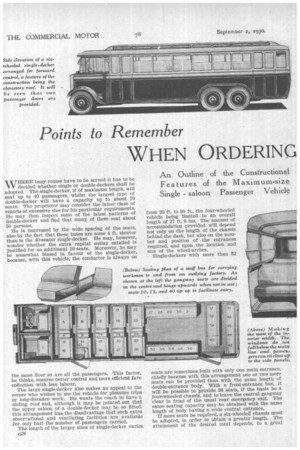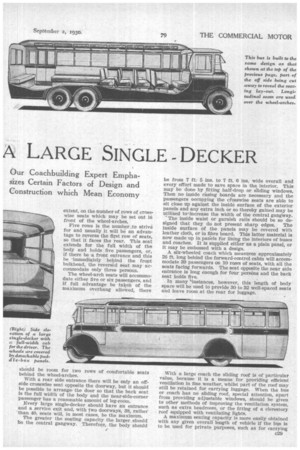Points to Remember
Page 50

Page 51

Page 52

If you've noticed an error in this article please click here to report it so we can fix it.
WHEN ORDERING A LARGE SINGLE DECKER
WHERE busy routes have to be served it has to be decided whether single or double-deckers shall be adopted. The single-decker, if of maximum length, will seat up to 40 passengers, whilst the largest type of double-decker will have a capacity up to about 70 seats. The proprietor may consider the latter class of vehicle of excessive size for his particular requirements. He may then inspect some of the latest patterns of double-decker and find that many of them seat about 50 persons.
He is impressed by the wide spacing of the seats, also by the fact that these buses are some 4 ft. shorter than is the 40-seater single-decker. He may, however, wonder whether the extra capital outlay entailed is justified for an additional 10 seats. Moreover, he may be somewhat biased in favour of the single-decker, because, with this vehicle, the conductor is always on the same floor as are all the passengers. This factor, he thinks, ensures better control and more efficient fare collection with less labour.
The large single-decker also makes an appeal to the owner who wishes to use the vehicle for pleasure trips or long-distance work. He wants the coach to have a sliding roof and, although it may be pointed out that the upper saloon of a double-decker may be so fitted, this arrangement has the disadvantage that such extra observational and ventilating facilities are available for only half the number of passengers carried.
The length of the larger sizes of single-decker varies 028 from 26 ft. to 30 ft., the four-wheeled vehicle being limited to an overall length of 27 ft. 6 ins. The amount of accommodation provided will depend not only on the length of the chassis behind the dash, but also on the number and position of the entrances required, and upon the location and size of the wheel-arches.
Single-deckers with more than 32 seats are sometimes built with only one main entrance, chiefly because with this arrangement one or two more seats can he provided than with the same length of double-entrance body. With a front-entrance bus, it will be possible to provide 36 gals, if the basis be a four-wheeled chassis, and to leave the central gangway clear in front of the usual rear emergency emit. The same seating capacity may be obtained with the same length of body having a wide central entrance.
If more seats be required, a six-wheeled chassis must be adopted, in order to obtain a greater length. The attainment of the desired total depends, to a great extent, on the number of rows of crosswise seats which may be set out in front of the wheel-arches.
Five rows is the number_to strive for and usually it will be an advantage to reverse the first row of seats, so that it faces the rear. This seat extends for the full width of the body and holds five passengers, or, if there be a front entrance and this be immediately behind the front bulkhead, the reversed seat may accommodate only three persons.
The wheel-arch seats will accommodate either five or six passengers, and if full advantage be taken of the maximum overhang allowed, there should be room for two rows of comfortable seats behind the wheel-arches.
With a rear side entrance there will be only an offside crosswise seat opposite the doorway, but it should be possible to arrange, the door so that the back seat is the full width of the body and the near-side-corner passenger has a reasonable amount of leg-robin.
Every large single-decker should have an entrance and a service exit and, with two doorways, 38, rather than 40, seats will, in most cases, be the maximum.
The greater the seating capacity the larger should be the central gangway. Therefore, the body should be from 7 ft. 5 ins. to 7 ft. 6 ins, wide overall and every effort made to save space in the interior. This may be done by fitting half-drop or sliding windows. Then no inside casing boards are necessary and the passengers occupying the crosswise seats are able to sit close up against the inside surface of the exterior panels and any extra inch or so thereby gained may be utilized to-'increase the width of the central gangway.
The inside waist or garnish rails should be so designed that they do not present sharp edges. The inside surface of the panels may be covered with leather cloth, or in fibre board. This latter material is now made up in panels for lining the interiors of buses and coaches. It is supplied either as a plain panel, or it may be embossed with a design.
A. six-wheeled coach which measures approximately 26 ft. long behind the forward-control cabin will accommodate 39 passengers on 10 roLws of seats, with all the seats facing forwards. The seat opposite the near side entrance is long enough for four persons and the back seat holds five.
In many instances, however, this length of body space will be used to provide 30 to 32 well-spaced seats and leave room at the rear for luggage.
With a large coach the sliding roof is of particular value, because it is a means for providing efficient ventilation in fine weather, whilst part of the roof may still be retained for carrying luggage. When the bus or coach has no sliding roof, special attention, apart from providing adjustable windows, should be given to other methods of improving the ventilation system, such as extra headroom, or the fitting of a clerestory roof equipped with ventilating lights.
A maximum seating capacity is more easily obtained with any given overall length of vehicle if the bus is to be used for private purposes, such as for carrying c29 workmen between an outlying factory and the bus routes or railway. The seats may be closely coupled and the capacity of the vehicle increased by means of gangway seats.
Although a gangwpy seat may be standardized so that it may be readily fitted into any vacant space, or entirely removed, such a pattern is liable to become broken or lost.
It is a better plan to hinge it to the end of the crosswise seat, so that, when required, it is always to hand. A simple pattern, which, when not in use, offers little obstruction, is made in two portions, each half being-hinged to its corresponding seat-end. When the passenger rises each half automatically springs up anti forms an arm-rest for the passenger in tbe outer of each pair of lateral seats.












































































































